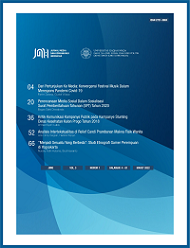Transportasi Isu Autisme Penonton Film: Analisis Fenomenologi Interpretatif Pengalaman Transportasi Para Ibu di Film My Name Is Khan
Sri Wijayanti(1*)
(1) Dosen Ilmu Komunikasi Universitas Pembangunan Jaya
(*) Corresponding Author
Abstract
Studi ini dilatarbelakangi kepedulian tentang arti penting pemahaman yang benar mengenai autisme. Selama ini, di kalangan masyarakat, isu autisme masih lazim disalahpahami. Film merupakan sarana yang tepat untuk mensosialisasikan isu autisme kepada khalayak sasaran. Karakteristik film dianggap dapat memenuhi gagasan narasi sebagai media persuasi. Untuk itu, studi ini bertujuan memperoleh pemahaman mendalam pengalaman transportasi isu autisme pada ibu sebagai penonton film My Name Is Khan (MNIK), yang diharapkan berperan besar dalam sosialisasi autisme. Transportasi dipahami sebagai pengalaman personal yang menyediakan sarana perjalanan imajiner di dunia narasi melalui keterlibatan individu terhadap pesan narasi. Analisis dilakukan dengan menggunakan teori Transportation Imagery Model (TIM) Green dan Brock yang kali ini melihat transportasi sebagai pengalaman personal dengan Interpretative Phenomenological Analysis sebagai analisis datanya. Hasil penelitian ini memberikan pemahaman mendalam dengan pendekatan idiografis mengeksplorasi pemaknaan pengalaman transportasi penonton film sebagai target persuasi dengan menjelaskan identifikasi dan interaksi parasosial sebagai bentuk keterlibatan dan cara pengolahan pesan persuasif. Secara teoritis, temuan penelitian ini mengembangkan konsep transportasi sebagai mediated relationships dalam kaitannya dengan studi persuasi narasi. Sedang secara metodologi, penelitian ini menunjukkan bahwa studi transportasi dengan pendekatan fenomenologi memungkinkan eksplorasi nuansa kontekstual dan intersubyektif individu yang mengalaminya. Sementara secara praktis, temuan penelitian ini berguna bagi para komunikator kesehatan yang ingin menggunakan film sebagai media persuasi, dengan mempertimbangkan peran penting transportasi individu sebagai strategi formulasi pesan.
Keywords
Full Text:
PDFReferences
Bilandzic, H., & Busselle, R. (2010). Measuring Narrative Engagement. Media Psychology.
Biocca, F. (2002). The evolution of interactive media: Toward "being there" in nonlinear narrative worlds. In M. C. Green, J. J. Strange, & T. C. Brock (Eds.), Narrative impact: Social and cognitive foundations , 97–130. New Jersey: Lawrence Erlbaum Associates Publishers.
Bruner, J. (1986). Actual minds, possible worlds. Cambridge: Harvard University Press
Bruner, J. (1991). Narrative construction of reality. Critical inquiry.
Buchanan, William James. (2013), The Phenomenological Experience of Narrative Transportation, Florida: University of Central Florida
Busselle, R. W., Bilandzic, H., & Zhou, Y. (2009). The influence of television fiction on real world victim sympathy: The roles of narrative engagement and counterarguing. Paper presented at the annual meeting of the ICA, Chicago, IL
Caelli, Kate. (2001). Engaging with Phenomenology: Is it more of a Challenge than it Needs to be?. Qualitative health research.
Chaiken, S. (1980). Heuristic versus systematic information processing and the use of source versus message cues in persuasion. Journal of Personality and Social Psychology.
Creswell, John W (2014). Reserach Design, Qualitative, Quantitative and Mixed Approaches, 4th Eds, Sage Publications Inc USA
Csikszentmihalyi, M. (1997). The masterminds series. Finding flow: The psychology of engagement with everyday life. Basic Books.
de Witt, Lorna & Ploeg, Jenny. (2006). Critical appraisal of rigour in interpretive phenomenology. Journal of advanced nursing.
Devito, Joseph. 1997. Komunikasi Antarmanusia. Professional Books: Jakarta
Green Melanie C. & Brock Timothy (2005) Persuasion, Psychological Insights and Perspectives (2nd Edition). Thousand Oaks, CA : Sage Publications Inc
Green, M. C., & Brock, T. C. (2000). The Role of Transportation in The Persuasiveness of Public Narratives. Journal of Personality and Social Psychology.
Green, M.C., & Brock, T.C. (2002). In the mind’s eye: Transportation-imagery model of narrative persuasion. In Green, M.C., Strange, J.J., & Brock, T.C. (Eds.), Narrative impact: Social and cognitive foundations (315-341). Mahwah, NJ: Lawrence Erlbaum Associates
Kinnebrock, Susanne & Bilandzic, Helena (2006). How to Make a Story Work: Introducing the Concept of Narrativity into Narrative Persuasion. International Communication Association Conference in Dresden Germany
Koch, T. (1996). Implementation of a hermeneutic inquiry in nursing: Philosophy, rigor and representation. Journal of Advanced Nursing.
Laverty, S. M. (2003). Hermeneutic Phenomenology and Phenomenology: A Comparison of Historical and Methodological Considerations. International Journal of Qualitative Methods.
Lopez, Kay & Willis, Danny. (2004). Descriptive Versus Interpretive Phenomenology: Their Contributions to Nursing Knowledge. Qualitative health research.
Moran, Dermot. (2000). An Introduction to Phenomenology. London: Routledge
Moustakas, Clark E. (1994). Phenomenological Research Methods USA: Sage Publications
Moyer-Guse, E., & Nabi, R. L. (2008). Explaining the persuasive effects of entertainment education programming: an empirical comparison of three theories. Paper presented at the annual meeting of the NCA, San Diego, CA
Petty, R. E. & Cacioppo, J. T. (1996). Attitudes and Persuasion: Classic and Contemporary Approaches. Oxford: Westview Press
Rouner, D., Slater, M. D., & Long, M. (2006). Narrative persuasion: Effects of subsequent discussion. Paper presented at the ICA annual convention, Dresden,Germany
Sadala, Maria & Adorno, Rubens. (2002). Phenomenology as a method to investigate the experience lived: a perspective from Husserl and Merleau Ponty's thought. Journal of advanced nursing.
Samovar, Larry A, Porter, Richard E. dan Jain, Nemi C., (1981). Understanding Intercultural Communication. Belmon, California: Wadswort Publishing Company.
Singhal, A., Cody, M.J., Rogers, E.M., & Sabido, M. (2004). Entertainment education and social change: History, research, and practice. Mahwah,NJ: Lawrence Erlbaum Associates, Inc.
Slater, M., & Rouner, D. (2002). Entertainment-education and elaboration likelihood: Understanding the processing of narrative persuasion.Communication Theory.
Sood, S. (2002). Audience involvement and entertainment-education. Communication Theory.
Stewart, David & Mickunas, Algis (1990). _Exploring Phenomenology: Guide to Field & is Literature_. Ohio: Ohio University Press.
Van Laer, T., De Ruyter, K., Visconti, LM & Wetzels M (2014). The Extended Transportation-Imagery Model: A Meta-Analysis of the Antecedents and Consequences of Consumers’ Narrative Transportation. Journal of Consumer Research Inc. Vol. 40 February, 2014
Wojkowski, J. & Skowera, Barbara. (2007). The structure of the radiation balance dependent on synoptic situations. Pami° etnik Puławski (Diary of Puławy) .
Yardley, Lucy. (2000). Dilemmas in qualitative research. Psychology & Health - PSYCHOL HEALTH.
Article Metrics
Refbacks
- There are currently no refbacks.
Copyright (c) 2020 Jurnal Media dan Komunikasi Indonesia
| Jurnal Media dan Komunikasi Indonesia (Online ISSN 2721-396X) is published by the Department of Communication Science (DIKOM), Faculty of Social Science and Political Science (FISIPOL), Gadjah Mada University |












